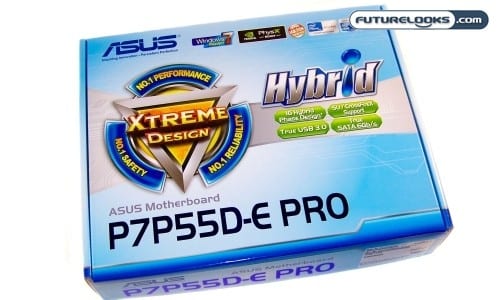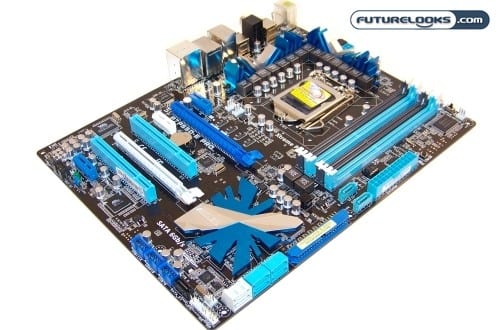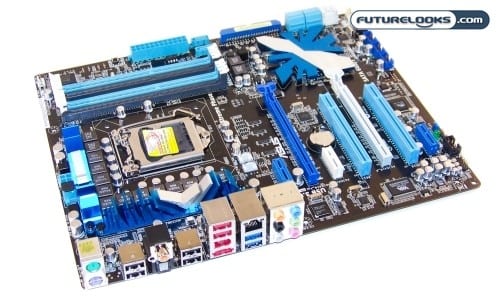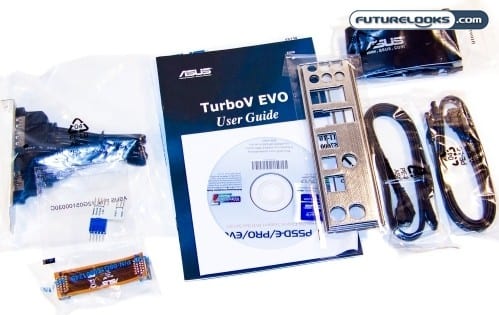
Now that all the USB 3.0 news, press releases, and product announcements are done, we can start to see some products rolling in to review. What this means is that the new P55 and X58 motherboards out there with USB 3.0 and SATA3 features can finally be put to some good use.
Take the ASUS P7P55D-E Pro Motherboard for example. It’s pretty much the paternal twin to the ASUS P7P55D Pro we reviewed a couple months ago. That single “E” is a powerful little vowel that indicates the platform provides both USB 3.0 and SATA3 support. Aside from these features let’s find out if the “E” stands for anything else.
Features and Specifications

What makes the Pro series stand out among others are the features built in to the platform. This includes the ASUS 16 Hybrid Phase technology with 12+2 Phase power design with extra T.Probes that monitors and manage the PWM. This allows for more power efficient performance especially when using TurboV EVO for some serious overclocking. More on that later.
Two exclusive features making a return are MemOK! and ASUS EPU. MemOK! will automatically find the memory settings needed for a successful boot. This comes in handy if you just installed some new memory and aren’t familiar with the BIOS options to set it up. ASUS EPU (energy processing unit) manages the system’s power requirements in real time for more efficient use so you can stay “green”.
Both boards also offer a VIA VT1828S 8-Channel HD Audio Codec. The drivers support features like Absolute Pitch 192/24 ENVY HD. You also get DTS Surround, as well as Coaxial and Optical S/PDIF out ports in the back. In past testing, the Codec’s features have proven decent for HD content playback, but only average regular audio playback. Such are the common traits of integrated audio.

Naturally, the boards offer the same exact number JMIcron JMB363 controlled SATA 2, UDMA (IDE), eSATA, and Firewire storage ports as well as P55 supported USB 2.0 ports. However, the D-E Pro model gets 2 Marvell controlled SATA 3 ports and 2 NEC controlled USB 3.0 ports.
The D-E also loses an x4 PCIe slot, but retains two x PCIe 2.0 x16 slots. Keep in mind that these slots run at x8/x8 when running two graphics cards in SLI or CrossfireX. Honestly, even we haven’t used the extra x4 PCIe slot on the original P7P55D Pro due to the realistic use of the platform which was just gaming.
What’s in the Box?
Bundles have been increasingly light these days. That’s not so surprising given the economy. But, if we’re not going to get a full package, perhaps we could get some usable extras like a handy USB flash drive, or at least make the bundled cabling a little flashier.

Despite thinning motherboard bundles, ASUS includes at least 4 black SATA cables. Can’t go wrong with black if you’re keeping with a theme. Asus also includes the standard flat ATA and Floppy cables as well as a PCI bracket that offers 2 more SATA and 1 eSATA port. And, yes, there’s a flexible SLI/Crossfire Bridge included for the hardcore gamers.
There’s also a handy user guide and IO plate which you may or may not need to get set up. It’s a pretty standard manual, so take your time and read slowly if needed. Most commonly, users have questions about which memory slots to use first and when to use the flexible SLI/Crossfire Bridge. We’ll save you the time: use the light blue slots for dual module memory kits. And, only use the Bridge when you’re running two identical video cards.
